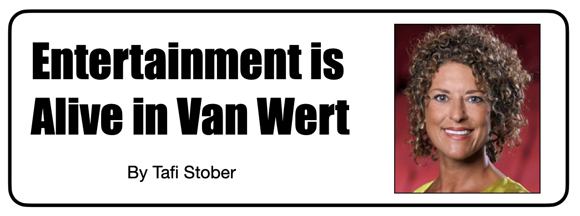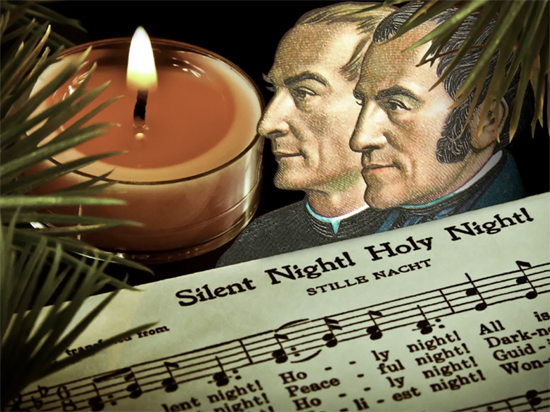
A Silent Night, The Gift Of Peace
The Niswonger stage will soon take a rest which appears to be just in time as old man winter gets his rightful time to shine, in his own blustery way. But do take heart. Even on the coldest day, there is so much more entertainment on the way. The roster for Spring, 2023 is nearly complete and filled with diversity. There are still a couple surprises yet to share and a 2023 grandstand announcement that might come as a pair. So stay warm and cozy by the fire until we come together once again.
On behalf of the Van Wert Live Team and VWAPAF Board of Directors, we would like to wish you and yours a very Merry Christmas. The joy of the season is complete in the songs we sing that gain value by understanding what their lyrics mean. “Silent Night” was composed to tell a story that gives healing and hope even on the coldest of days. So until we return for entertainment face to face may the beauty of this song comfort you like a warm embrace.
Over the centuries, hundreds of Christmas carols have been composed. Many fall quickly into obscurity Silent Night has stayed relevant more than 200 years after being written. It has since been translated into at least 300 languages and arranged in dozens of different musical styles, from heavy metal to gospel.
Silent night originated in a small Alpine town in the Austrian countryside enduring the fallout from war and famine. The song’s lyrics were originally written in German just after the end of the Napoleonic Wars by a young Austrian priest named Joseph Mohr.

In the fall of 1816, Mohr’s congregation in the town of Mariapfarr was reeling. Twelve years of war had decimated the country’s political and social infrastructure. This was followed by a catastrophic cold spell referred to as “The Year Without a Summer”. Furthermore, the eruption of Indonesia’s Mount Tambora in 1815 had caused widespread climate change throughout Europe. Volcanic ash in the atmosphere caused almost continuous storms – even snow – in the midst of summer. Crops failed and there was widespread famine. Mohr’s congregation was poverty-stricken, hungry, and traumatized. It was from this landscape that Mohr crafted a set of six poetic verses to convey hope that there was still a God who cared.
Although Joseph Mohr was a gifted violinist and guitarist he sought help from a friend Franz Xaver Gruber, a local schoolteacher and organist, to write the music for the six verses.
On Christmas Eve, 1818, the two friends sang “Silent Night” for the first time in front of Mohr’s congregation, with Mohr playing his guitar. The song was apparently well-received by Mohr’s parishioners, most of whom worked as boat-builders and shippers in the salt trade that was central to the economy of the region.
The melody and harmonization of “Silent Night” is actually based on an Italian musical style called the “siciliana” that mimics the sound of water and rolling waves: two large rhythmic beats, split into three parts each. In this way, Gruber’s music reflected the daily soundscape of Mohr’s congregation, who lived and worked along the Salzach River.
The song went on to become a worldwide phenomenon moving from Obendorf to Europe and on to America. According to a document written by Gruber in 1854, the song first became popular in the nearby Zillertal valley. From there, two traveling families of folk singers, the Strassers and the Rainers, included the tune in their shows. The song then became popular across Europe, and eventually in America, where the Rainers sang it on Wall Street in 1839.
At the same time, German-speaking missionaries spread the song from Tibet to Alaska and translated it into local languages. By the mid-19th century, “Silent Night” had even made its way to subarctic Inuit communities along the Labrador coast, where it was translated into Inuktitut as “Unuak Opinak.”
Since the beginning, the lyrics of “Silent Night” have carried an important message for Christmas Eve observances in churches around the world. But it’s the song’s lilting melody and peaceful lyrics that remind us of a universal sense of grace that unites people across cultures and faiths as demonstrated at The Christmas Truce of 1914. At the height of World War I, German and British soldiers on the front lines in Flanders laid down their weapons on Christmas Eve and together sang “Silent Night.”
The song’s fundamental message of peace, even in the midst of suffering, has bridged cultures and generations. “Silent Night” speaks of hope in hard times and of beauty that arises from pain. It brings comfort through unification. May you be surrounded by comfort and peace this Christmas and always.
Silent night, holy night!
All is calm, all is bright.
Round yon Virgin, Mother and Child.
Holy infant so tender and mild,
Sleep in heavenly peace,
Sleep in heavenly peace
Silent night, holy night!
Shepherds quake at the sight.
Glories stream from heaven afar
Heavenly hosts sing Alleluia,
Christ the Savior is born!
Christ the Savior is born
Silent night, holy night!
Son of God love’s pure light.
Radiant beams from Thy holy face
With dawn of redeeming grace,
Jesus Lord, at Thy birth
Jesus Lord, at Thy birth
POSTED: 12/20/22 at 1:55 pm. FILED UNDER: Arts & Entertainment







